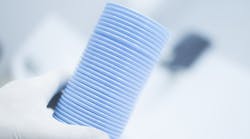We are all aware that we are in the midst of a pandemic. Everyone has experienced empty waiting rooms, burning up in multiple layers of personal protective equipment (PPE), and increased disinfection efforts, but maybe there is a silver lining. We can look at this as an opportunity to update our infection control, which is important to our patients, ourselves, and our families. There is no better time than the present because you now have your doctor’s attention.
Like the HIV/AIDS epidemic in the 1980s, this pandemic is causing us to change how we practice. The changes we made at that time were a necessary improvement, and so are the ones that we are making now. There was a time when it was acceptable to treat a patient without wearing gloves, but now, they are the standard of care.1 Prerinsing has been recommended for some time, but is just now recognized as a crucial step in infection control.
The danger of dental aerosols is no secret. Much of our current PPE is designed to create a barrier between us and aerosols; however, prerinsing kills the microbes before they become aerosolized. Does this work? Let’s look to science. One study completed showed that preprocedural rinsing reduces 97% of pathogens in aerosols. The study made this discovery by taping agar plates up all over a treatment room. Then, after the aerosol exposure, the plates were grown in an incubator. When the patient prerinsed before treatment, there was 94% less bacterial growth. That translates to fewer bacteria on the counters, walls, equipment, in the air, on the operator’s clothes, and in the clinician’s lungs.2 This confirms that, at minimum, a simple prerinse can reduce the amount of contaminants lingering in the air around us.
Though prerinsing is a simple step, choosing the right rinse can be complex. The current environment has us scrutinizing viruses, when traditionally our focus has been mainly on bacteria.3 Therefore, many commonly used prerinses (e.g., chlorhexidine and alcohol-based products) do very little to remove viruses.4,5 A prerinse should have the ability to not only kill bacteria, but also viruses and fungi.
Another requirement of a good prerinse is the ability to kill quickly, ideally in one minute or less. Having to wait five to 10 minutes for your prerinse to work is not practical in a typical dental setting. Who has that much time to wait before being able to work on their patient? Hydrogen peroxide, for example, has little virucidal activity until in contact for five minutes. Furthermore, effectiveness appears to decrease with a concentration of the active ingredient.
A study by the American College of Prosthodontists using commercially available rinses (1.5% and 3% hydrogen peroxide) reveals that these concentrations offer minimal virucidal activity at both 15 and 30 second exposures, which are typical rinse times.6
When searching for ingredients that kill bacteria, fungi, and viruses, few beat the oxidizing power of chlorine dioxide. Though newer to dentistry, chlorine dioxide has been used for nearly 200 years to help with disinfection in other industries. As an oxidizer, chlorine dioxide is extremely selective, in contrast to other oxidizers such as ozone and peroxide.
What does it mean to be selective? Higher-power oxidants (ozone and peroxide) are less discriminating in what they break down, meaning they will react with many of the other constituents of the saliva. The oxidation potential gets used up before it has a chance to react with the actual targeted pathogen. Furthermore, it also reacts with the cells of the body, which negatively impacts tissue response. This is why surgeons do not traditionally use products containing peroxide.7
Chlorine dioxide is safe and effective. The US military has even used it to sterilize medical equipment and electronic items used in the treatment of patients on the front lines of the war on Ebola in West Africa. It has also shown historical use and effectiveness against influenza A.8
One of the products that utilizes activated chlorine dioxide is OraCare. It has many patient uses, but for the last 10 years has been used for pre- and postrinsing. Additionally, a recent study confirmed OraCare’s ability to kill human coronavirus, with zero cell toxicity.9 Not only can OraCare help improve your patients’ oral health, it can protect you as a dental professional.
As with all things, educate yourself because there are so many options available. A prerinse in some form is always better than nothing at all. Just be sure that the rinse you choose kills all of the microbes with no negative impact on your patient.
Editor’s note: This article is sponsored by OraCare. Content has been reviewed for editorial integrity per RDH guidelines. For more information on RDH editorial, see rdhmag.com/page/submission-guidelines.
References
1. Kohn WG, Collins AS, Cleveland JL, et al. Guidelines for infection control in dental health care settings — 2003. MMWR Recomm Rep. 2003;52(RR-17):1-68. Accessed September 2020. http://www.cdc.gov/mmwr/preview/mmwrhtml/rr5217a1.htm.
2. Sawhney A, Venugopal S, Babu GR, Garg A, Mathew M, Yadav M, Gupta B, Tripathi S. Aerosols how dangerous they are in clinical practice. J Clin Diagn Res. 2015;9(4):ZC52-7. doi: 10.7860/JCDR/2015/12038.5835
3. Asai D., Nakashima H. Pathogenic viruses commonly present in the oral cavity and relevant antiviral compounds derived from natural products. Medicines. 2018;5:120. doi: 10.3390/medicines5040120
4. Yoon JG, Yoon J, Song JY, et al. Clinical significance of a high SARS-CoV-2 viral load in the saliva. J Korean Med Sci. 2020;35:e19. doi:10.3346/jkms.2020.35.e195
5. Moosavi MS, Aminishakib P, Ansari M. Antiviral mouthwashes: possible benefit for COVID-19 with evidence-based approach. J Oral Microbiol. 2020;12(1):1794363. doi:10.1080/20002297.2020.1794363
6. Bidra AS, Pelletier JS, Westover JB, et al. Comparison of in vitro inactivation of SARS CoV‐2 with hydrogen peroxide and povidone‐iodine oral antiseptic rinses. J Prosthodont. 2020;29(7):599-603. doi:10.1111/jopr.13220
7. From policy to practice: OSAP’s guide to the guidelines. Annapolis, MD: Organization for Safety and Asepsis Procedures; 2020:29-38.
8. Miura T, Shibata T. Antiviral effect of chlorine dioxide against influenza virus and Its application for infection control. Taiko Pharmaceutical Co. April 2010. https://benthamopen.com/contents/pdf/TOANTIMJ/TOANTIMJ-2-71.pdf
9. Smith T. Microchem Labratories Study NG15104. Round Rock: ProBreath LLC. https://www.oracareproducts.com/uploads/4/3/7/3/43731917/human_corona_virus_study.pdf
Kristin Goodfellow, RDH, is the director of clinical education at OraCare. She obtained her bachelor’s degree in communication studies from West Virginia University and her associate’s degree in dental hygiene from Allegany College of Maryland. Her outstanding chairside education earned her the Procter & Gamble Excellence in Patient Communication Award in 2013.







